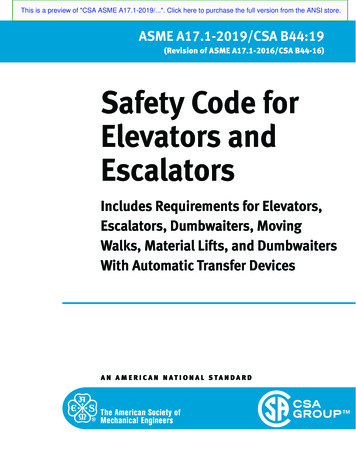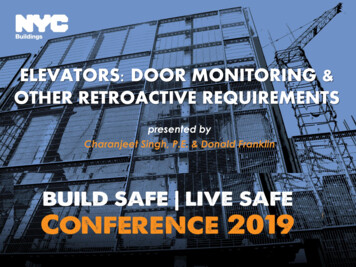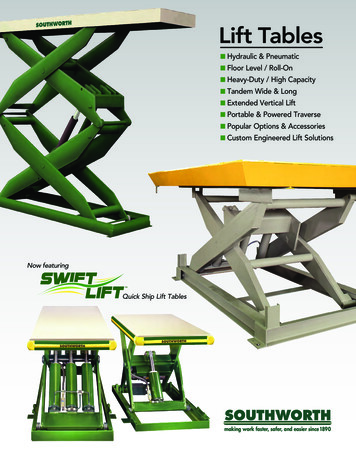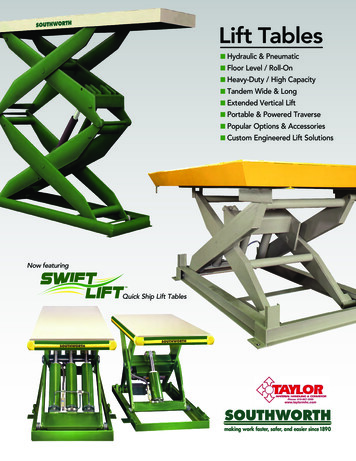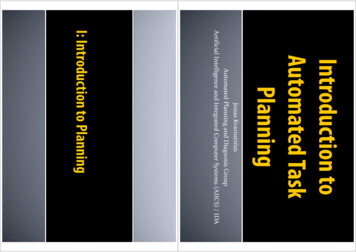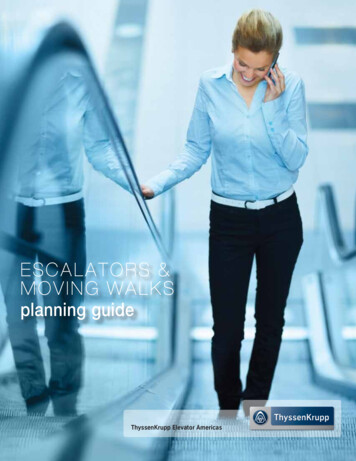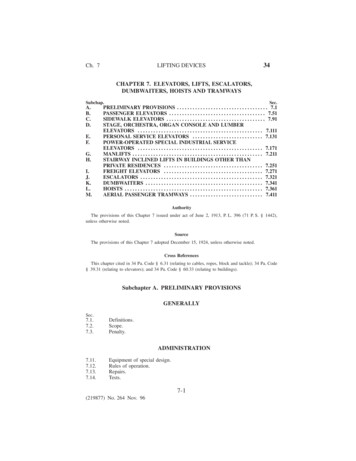
Transcription
Ch. 7LIFTING DEVICES34CHAPTER 7. ELEVATORS, LIFTS, ESCALATORS,DUMBWAITERS, HOISTS AND IMINARY PROVISIONS . . . . . . . . . . . . . . . . . . . . . . . . . . . . . . . . . . . 7.1PASSENGER ELEVATORS . . . . . . . . . . . . . . . . . . . . . . . . . . . . . . . . . . . . . 7.51SIDEWALK ELEVATORS . . . . . . . . . . . . . . . . . . . . . . . . . . . . . . . . . . . . . . 7.91STAGE, ORCHESTRA, ORGAN CONSOLE AND LUMBERELEVATORS . . . . . . . . . . . . . . . . . . . . . . . . . . . . . . . . . . . . . . . . . . . . . . . . 7.111PERSONAL SERVICE ELEVATORS . . . . . . . . . . . . . . . . . . . . . . . . . . . 7.131POWER-OPERATED SPECIAL INDUSTRIAL SERVICEELEVATORS . . . . . . . . . . . . . . . . . . . . . . . . . . . . . . . . . . . . . . . . . . . . . . . . 7.171MANLIFTS . . . . . . . . . . . . . . . . . . . . . . . . . . . . . . . . . . . . . . . . . . . . . . . . . . 7.211STAIRWAY INCLINED LIFTS IN BUILDINGS OTHER THANPRIVATE RESIDENCES . . . . . . . . . . . . . . . . . . . . . . . . . . . . . . . . . . . . . . 7.251FREIGHT ELEVATORS . . . . . . . . . . . . . . . . . . . . . . . . . . . . . . . . . . . . . . 7.271ESCALATORS . . . . . . . . . . . . . . . . . . . . . . . . . . . . . . . . . . . . . . . . . . . . . . . 7.321DUMBWAITERS . . . . . . . . . . . . . . . . . . . . . . . . . . . . . . . . . . . . . . . . . . . . . 7.341HOISTS . . . . . . . . . . . . . . . . . . . . . . . . . . . . . . . . . . . . . . . . . . . . . . . . . . . . . 7.361AERIAL PASSENGER TRAMWAYS . . . . . . . . . . . . . . . . . . . . . . . . . . . . 7.411AuthorityThe provisions of this Chapter 7 issued under act of June 2, 1913, P. L. 396 (71 P. S. § 1442),unless otherwise noted.SourceThe provisions of this Chapter 7 adopted December 15, 1924, unless otherwise noted.Cross ReferencesThis chapter cited in 34 Pa. Code § 6.31 (relating to cables, ropes, block and tackle); 34 Pa. Code§ 39.31 (relating to elevators); and 34 Pa. Code § 60.33 (relating to buildings).Subchapter A. PRELIMINARY ment of special design.Rules of operation.Repairs.Tests.7-1(219877) No. 264 Nov. 96
34 § 7.17.15.7.16.7.17.DEPARTMENT OF LABOR & INDUSTRYPt. IInspection.Inspectors.Prohibited installations.SPECIFICATIONS—ALL HOISTING AND LOWERING sion and approval of plans.Fire prevention.Operation of elevators under fire or other emergency conditions.Lighting and electric wiring.Electrical insulating floor mats.Data plates and numbering.Combination elevators.GENERALLY§ 7.1. Definitions.The following words and terms, when used in this chapter, have the followingmeanings, unless the context clearly indicates otherwise:Aerial passenger tramway—A general usage which denotes a device used totransport passengers by single and double reversible tramway; chair lifts, gondola lifts and skimobiles; T-bar lifts, J-bar lifts, platter lifts and similar devices;or a fiber rope tow.Automatic control elevator—An elevator, the operation of which is controlled by electric buttons or switches in such a manner that all stops at landings are made automatically and which may be started by switches or buttonsat the landing.Basement—A floor level partly or completely below grade as measured fromthe floor level immediately above; it shall be considered a story if more than33-1/3% of the exterior wall perimeter is five feet or more above grade.Basement lift—A sidewalk elevator.Bucket—A metal bucket or tank operating in guides raised and lowered bysteel cables and used for the purpose of distributing concrete or other buildingmaterial to various floor levels.Builder’s hoist—An elevator erected for temporary use, built in or adjoininga building under construction or alterations.Car door or gate—The door or gate in an elevator car.Chair lifts, gondola lifts, and skimobiles—A type of transportation in whichpassengers are carried on chairs or cars, or in gondola cabs attached to andsuspended from a moving wire rope or attached to a moving wire rope or chainand supported on a standing wire rope or other structure.Diameter—Tread diameter when it refers to sheaves, wheels, or pulleys.7-2(219878) No. 264 Nov. 96Copyright 娀 1996 Commonwealth of Pennsylvania
Ch. 7LIFTING DEVICES34 § 7.1Double-button control elevator—An elevator, the operation of which is controlled by self-centering buttons or switches located in the car and at the landings in such a manner that the elevator operates only when the button or switchis held closed manually and stops when the button or switch is released.Double-deck—An elevator consisting of a car structure containing two elevator cabs or compartments.Drive sheave, or bull wheel—The tread diameter which ranges from three to14 feet, depending upon the type of installation. Either designation refers to themain drive sheave.Dual control elevator—An elevator capable of operation either by an authorized operator in the car or automatically by electric buttons or switches.Dumbwaiter—A miniature freight elevator.Elevator—A car, cage, or platform raised or lowered vertically in permanentguides or rails, including the necessary operating mechanism, used to transportpersons or materials.Elevator car—The load carrying unit, including the platform supporting andguiding frame, and enclosure.Escalator—A moving continuous inclined stairway or runway used for raising or lowering persons. Wheeled vehicles of any type are not permitted onescalators.Fiber rope tow—A type of transportation which pulls skiers riding on skis bya traveling fiber rope which the skier grasps by hand.Fire-resistive materials—Approved materials having fire-resistive qualities,such as brick, concrete, hollow tile, terra-cotta blocks, or concrete plaster onexpanded metal lath supported by metal studs of an approximate total thicknessof not less than 2 1/2 inches.Freight elevator—An elevator constructed and used for carrying materials.Full automatic door or gate—A door or gate which is opened and closedautomatically by the motion of the elevator car.Grade—The level or the surface of the ground established by law, or onrecord where not established by law. This term includes the average level of thesurface of the ground.Gravity elevator—A freight elevator used for lowering materials in a car,cage, or platform through a shaftway, the operation of which is accomplishedby the excess weight of the car, cage or platform and the load over the carcounterweights.Hand elevator—A freight elevator, the machinery of which is actuated by arope or cable operated exclusively by hand.Independently-operated door or gate—A door or gate operated by powerfrom an auxiliary source in no way derived from the motion of the car.Landing—The floor, balcony, or platform used to receive or discharge passengers or freight from an elevator car.7-3(219879) No. 264 Nov. 96
34 § 7.1DEPARTMENT OF LABOR & INDUSTRYPt. ILanding door or gate—The door or gate at the shaftway entrance of anylanding.Locking device—A device which prevents the operation of an elevator awayfrom the landing while any gate or door at that landing is open and unsecuredand also prevents the opening of the door unless the car is at the landing; thisterm is also referred to as ‘‘interlock.’’Lumber elevator—A platform equipped with screws to raise or lower stackedlumber in a vertical direction at a speed not exceeding 15 feet per minute, witha travel not exceeding 20 feet.Machinery—The hoisting mechanism and equipment used in the operation ofan elevator.Manlift—The type of elevator which operates by an endless vertical beltwhich revolves over fixed pulleys at the top and bottom limits of travel and towhich steps and hand holds are attached so that persons may ride on it.Manually-operated door or gate—A door or gate which is opened and closedby hand.Orchestra elevator—A platform for raising and lowering musicians in anorchestra in a vertical direction at a speed not exceeding 15 feet per minute.Organ console elevator—A platform for raising and lowering an organ console, including the organist, in a vertical direction at a speed not exceeding 15feet per minute.Passenger elevator—An elevator constructed and operated to transport persons.Private dwellings—Convents, rectories, and parsonages, which are ex- emptfrom this chapter, unless portions thereof are used for the housing or assembling of persons other than members of the religious order, if the occupancy isnot in excess of 25 persons.Rated capacity—The capacity established by the designer of equipment.Rope—Wire rope, and cable are interchangeable, except for rope tows if ropemeans a fiber rope.Safety gate stops—A device which automatically stops a tramway when incontact with a passenger or the weight of a passenger.Semiautomatic door or gate—A door or gate which is manually opened butautomatically closed when the elevator car leaves the landing.Shaftway—A shaft, well-hole, hatchway or other vertical opening or space,partly or wholly enclosed within which an elevator is raised or lowered in avertical direction.Sheaves—Pulleys or wheels grooved for rope.Sidewalk elevator—An elevator which travels from a point below the sidewalk level to the sidewalk, or to an elevation not to exceed wagon or freightcar loading level.7-4(219880) No. 264 Nov. 96Copyright 娀 1996 Commonwealth of Pennsylvania
Ch. 7LIFTING DEVICES34 § 7.2Single or double reversible tramway—A type of transportation in which passengers are carried in one or more enclosed cars that reciprocate between terminals.Stage elevator—A platform consisting of a section of the stage arranged tobe raised and lowered above and below the stage level in a vertical direction ata speed not exceeding 15 feet per minute.Stairway inclined lift—A power passenger inclined lift installed on a stairway for raising or lowering persons from one floor to another.Standard railing—A railing not less than 42 inches in height with an additional rail midway between the top rail and the floor.T-bar, J-bar and platter lifts and similar devices—Types of transportationwhich pull skiers riding on skis by devices propelled by a main overhead traveling wire rope.Toeboard—A board at least 6 inches in height, placed at right angles withfloor or platform to prevent objects from falling from the floor or platform tothe spaces below.Winch—A hand or power-operated machine having a rope coiled on one ormore drums for the purpose of hauling, hoisting or lowering a load.Workmen’s hoist—A hoist installed in or outside of buildings during construction, alteration or demolition, and used primarily to raise or lower workmen and other persons connected with or related to the building project.AuthorityThe provisions of this § 7.1 issued under act of May 2, 1929 (P. L. 1518, No. 452) (35 P. S.§§ 1341—1356).SourceThe provisions of this § 7.1 amended through December 19, 1980, effective December 20, 1980,10 Pa.B. 4723. Immediately preceding text appears at serial pages (17285) and (36688).§ 7.2. Scope.This chapter sets forth rules to safeguard the lives, limbs, maintenance andhealth of workers involved in the installation, operation and maintenance ofelevators, lifts, escalators, dumbwaiters, hoists and tramways in this Commonwealth, and places the responsibility of compliance with the rules upon bothemployer and employe.§ 7.3. Penalty.Any person who violates any of the provisions of this chapter is subject tosummary proceedings before an alderman, magistrate or district justice and uponconviction, shall be penalized as provided in section 16 of the act of May 2, 1929(P. L. 1513, No. 451) (35 P. S. § 1356).7-5(219881) No. 264 Nov. 96
34 § 7.11DEPARTMENT OF LABOR & INDUSTRYPt. IADMINISTRATION§ 7.11. Equipment of special design.The operation, erection and installation of types of hoisting and loweringequipment other than those covered in this chapter is subject to approval by theDepartment. When installing elevators with specially designed apparatus orequipment not provided for by this chapter, the elevators may not be operateduntil the design in question has been approved by the Department.Cross ReferencesThis section cited in 34 Pa. Code § 7.251 (relating to general).§ 7.12. Rules of operation.(a) Passenger or freight elevators, except when operated by automatic controlor double-button control, shall be operated only by authorized persons who havereceived instruction in the proper operation thereof.(b) No person shall be allowed to operate an elevator unless he is at least 18years of age and is selected with consideration for his ability to perform his dutiesin a careful and competent manner, and is free from mental or serious physicaldefects.(c) Operators of elevators shall see that all the provisions of this chapter arecomplied with. Operators shall report to their employers any violations or defectswhich come to their attention.(d) No person shall ride on elevators constructed and used as power-drivenfreight elevators, except the operator and designated assistants (not more thanthree). No person shall ride upon hand elevators, gravity elevators, dumbwaiters,or hoists.(e) A duplex elevator requires operators in each cab or compartment.(f) When seats are placed in the cars of elevators for the use of elevatoroperators they shall be of the collapsible type and without legs.(g) The provisions of this section apply to all installations.Cross ReferencesThis section cited in 34 Pa. Code § 7.251 (relating to general); 34 Pa. Code § 7.37 (relating tocombination elevators); and 34 Pa. Code § 7.283 (relating to safety requirements).§ 7.13. Repairs.(a) Any existing device subject to this chapter which is damaged by fire orother causes including ordinary wear, when major repairs or replacement becomenecessary, shall be replaced or rebuilt in conformity with the requirements of thischapter for new construction and installation of such devices, except that it is notrequired that the hoistway be fireproof when the existing hoistway is used.7-6(219882) No. 264 Nov. 96Copyright 娀 1996 Commonwealth of Pennsylvania
Ch. 7LIFTING DEVICES34 § 7.13(b) The removal and reerection of elevators, escalators, and dumbwaiters innew locations shall be in conformity with the requirements for new elevators,escalators, and dumbwaiters. Existing hoists, when used as permanent installations, may not be reerected in new locations.(c) Before work costing 1,000 or more is commenced on the repair ofelevator devices, duplicate applications for such repair work shall be filed withthe Department by the building owner or the elevator contractor. Before workcosting 1,000 or more and involving major repairs as defined in subsection (e)is commenced on the repair of elevator devices, duplicate applications for suchrepair work plus a 50 fee for a permit shall be filed with the Department by thebuilding owner or the elevator contractor and a permit covering such repairs orchanges shall be obtained from the Department.(d) After work costing 1,000 or more is completed, the building owner orelevator contractor shall notify the Department and such repairs may be inspectedby the Department for approval. After work costing 1,000 or more and involving major repairs as defined in subsection (e) is completed, the building owner orelevator contractor shall notify the Department and such repairs will be inspectedby the Department for approval.(e) Major repairs shall include but shall not be limited to the followingchanges in an elevator: increase in the rated load or speed, increase in the deadweight of the car, change in travel, change in the type of operation or control,change in the size or number of suspension ropes, change in the size or type ofguide rails, change in classification from freight elevator to passenger elevator,change in the power supply, change in the type of car or counterweight safety,installation of a new driving machine, installation of a new controller, installationof new brakes, replacement of hoistway doors, addition of landing door interlocks, addition of door operating devices, addition of auxiliary rope fasteningdevices, addition of car leveling, addition of roller guide shoes, and addition ofnew car or counterweight safety. As to hydraulic elevators, major repairs shallinclude the preceeding changes as appropriate, and shall include but shall not belimited to the following changes: installation of different control valves, replacement of existing relief and check valves, replacement of existing supply pipingsand fittings, replacement of existing tanks, replacement of cylinder, replacementof plunger, and increase in the working pressure by more than 3.0%.AuthorityThe provisions of this § 7.13 issued under act of May 2, 1929 (P. L. 1518, No. 452) (35 P. S.§§ 1341—1356).SourceThe provisions of this § 7.13 amended December 19, 1980, effective December 20, 1980, 10 Pa.B.4723. Immediately preceding text appears at serial pages (8045) and (8046).7-7(219883) No. 264 Nov. 96
34 § 7.14DEPARTMENT OF LABOR & INDUSTRYPt. ICross ReferencesThis section cited in 34 Pa. Code § 7.251 (relating to general).§ 7.14. Tests.(a) New passengers and freight elevators shall be tested in the presence of aDepartment inspector to see that the car safeties, speed governors, brakes,bumpers, limit switches, and the like, perform their proper functions. The carsafeties shall be tested with the elevator car carrying the maximum allowableload. In making the final test the hoisting cables shall be detached from the car,while at a height sufficient to indicate the efficiency of the car safeties. A runaway test is acceptable in lieu of the free drop test when approved safety devicesare installed. For reostatic control elevators, the safeties shall be tested by tripping the governor. Broken rope safety devices shall be tested as such.(b) Existing installations shall be tested as follows:(1) The car safety of existing installations shall be tested with rated load inthe car by tripping the governor by hand at rated speed, within five years ofeffective date and at least every five years thereafter by a reputable elevatorcompany. Results of the test shall be certified by the elevator company onforms furnished by the Department, indicating the load for which the elevatorwas tested and a record of such test shall be filed with the Department.(2) A metal data plate furnished by the company performing the test shallbe fastened to the car crosshead and show the date of the test and the companyperforming the test.(3) The governor shall be tested and the trip speed measured by a tachometer and, if necessary, adjusted to conform to the requirements of this section.Governors shall be resealed after each test. Speed governors for car safetiesshall be set to trip at over speeds as follows:(i)At not less than 115% of rated car speed.(ii) At not more than the tripping speed listed opposite the applicablerated speed in the following table:Maximum Speeds at which Speed Governor Tripsand Governor Overspeed Switch OperatesRated Speed(in feet per minute)Maximum GovernorTrip Speed(in feet per minute)Maximum Speed at whichGovernor OverspeedSwitch Operates(down feet per 1902252522773037-8(219884) No. 264 Nov. 96Copyright 娀 1996 Commonwealth of Pennsylvania
Ch. 734 § 7.14LIFTING DEVICESRated Speed(in feet per minute)Maximum GovernorTrip Speed(in feet per minute)Maximum Speed at whichGovernor OverspeedSwitch Operates(down feet per 148215961710(4) Speed governors, where provided for counterweight safeties, shall beset to trip at an overspeed greater than, but not more than 10% above, that atwhich the car speed governor is set to trip.(5) Broken rope safeties shall be drop tested.(6) The provisions of this subsection do not apply to hand-powered freightelevators.(c) New escalators shall be tested in the presence of a Department inspector.The test shall consist of a physical examination of the escalator parts togetherwith a running test of the escalator without load, including a test of all the safetyfeatures prescribed in § 7.324 (relating to safety equipment).(d) On the completion of any device provided for by this chapter, the owner,builder, contractor, manufacturer, or other responsible party or parties, shall filewith the Department notice in writing that such installation has been constructedand installed in accordance with the plans as approved. Upon receipt of suchnotice the Department may arrange for inspection of the installation by a Department inspector.(e) New elevators, escalators, dumbwaiters, gravity elevators and hoists shallnot be operated temporarily pending final completion without permission of theDepartment.SourceThe provisions of this § 7.14 amended through June 21, 1974, 4 Pa.B. 1282. Immediately preceding text appears at serial pages (8047) and (8048).7-9(219885) No. 264 Nov. 96
34 § 7.15DEPARTMENT OF LABOR & INDUSTRYPt. ICross ReferencesThis section cited in 34 Pa. Code § 7.251 (relating to general).§ 7.15. Inspection.(a) Frequency. Inspection of equipment regulated by this chapter shall takeplace as follows:(1) All passenger elevators and escalators shall be inspected at least onceevery 3 months.(2) Freight elevators, including gravity elevators, shall be inspected at leastonce every 6 months.(3) Dumbwaiters, hoists, and other types of lifting apparatus covered bythis chapter shall be inspected once every 12 months. Building hoists may beinspected by a Department inspector at the time of erection at every building.(4) Inspections shall be made by approved inspectors. During inspectionsall safety appliances shall be thoroughly examined and all violations reported.Casualty insurance companies insuring such installations shall inspect themperiodically, in keeping with the type of equipment insured. When installationsare idle for an extended period of time they are not subject to the requirementsof this section if they are placed under State seal, but may be thoroughlyinspected by a Department inspector before again being placed in operation.(b) Reports. Approved inspectors shall file with the Department duplicatecopies of all inspection reports which pertain to and cover all elevators and hoistsinspected, and which are located within the jurisdiction of the Department.(c) Certificates. Upon the receipt of reports, the Department will, upon thepayment of a fee proportionate to an annual fee of 4.00, issue certificates ofinspection covering all installations which are found to conform to the provisionsof this section. Certificates shall be posted in the cars of elevators, and in conspicuous places in connection with escalators and hoists. The name of the inspector making the inspection and the dates of issuance and expiration shall appearon all certificates. If such installation is insured, the name and address of theinsurance carrier shall also be placed upon the certificate. Elevators shall not beoperated before the certificate is received from the Department and posted, orafter the effective period of the certificate expires. Approved elevator inspectorsand other inspectors regularly employed by the Department may order an elevator to be placed out of service if the foregoing provision is violated. The insurance company carrying the risk shall notify the Department when risk expires.(d) Noncompliance with recommendations. In all instances when imperativerecommendations are issued, and when such recommendations have not receivedthe attention of owners, the issuance of certificates of inspection may be withheld, until such time as the substandard conditions are rectified.(e) Unsafe conditions. Approved inspectors finding a violation which causesa dangerous condition will immediately notify the building owner or agent of thebuilding owner of the violation and advise such person to place the elevator out7-10(219886) No. 264 Nov. 96Copyright 娀 1996 Commonwealth of Pennsylvania
Ch. 7LIFTING DEVICES34 § 7.16of service. Immediately thereafter he shall notify the local elevator inspector ofthe Department so that a seal may be placed on the elevator. No elevator shall beoperated after being placed out of service by an inspector until the violations havebeen corrected and approved by the Department.Cross ReferencesThis section cited in 34 Pa. Code § 7.134 (relating to approval and operation); 34 Pa. Code§ 7.174 (relating to approval and operation); 34 Pa. Code § 7.213 (relating to approval and operation); and 34 Pa. Code § 7.251 (relating to general).§ 7.16. Inspectors.(a) The Department will hold examinations for applicants as approved elevator inspectors, four times a year, on the first Thursday after the first Wednesdayin March, June, September and December, or at such other times as the Boardmay direct. Special examinations may be held when necessary. Persons desiringto take the examination shall forward their applications to the Department not lessthan ten days prior to the date of examination, accompanied by a fee of 40.(b) All applicants found competent through examinations will be awarded,upon the payment of a fee of 20, a commission and a credential card, authorizing them to inspect elevators, escalators, dumbwaiters, gravity elevators andhoists in the names of the agencies they represent. Credential cards will berenewed annually upon the payment of a fee of 10.(c) No elevator inspector will be approved who is an employe of the owneror user of the elevators to be inspected, nor will elevator inspectors be approvedto inspect elevators under the jurisdiction of the Department if they are notemployes of the Department or of casualty and insurance companies authorizedto do business in this Commonwealth or of a firm engaged in the making ofinspections on a fee or contract basis when performing inspections on such basisfor an insurance carrier.(d) No person shall inspect elevators who is not a bona fide employe of theCommonwealth or of an insurance carrier authorized to do business in this Commonwealth or of a firm engaged in the making of inspections on a fee or contractbasis when performing inspections on such basis for an insurance carrier. For thepurposes of this rule, the term employe means any person who is directly responsible to the employer for all work performed, and who receives as compensationa regular salary based on full or part-time employment and for whom compensation insurance is carried by the employer. It does not include the relationship ofagent on a commission basis.SourceThe provisions of this § 7.16 amended through June 12, 1975, 5 Pa.B. 1558. Immediately preceding text appears at serial page (8050).7-11(219887) No. 264 Nov. 96
34 § 7.17DEPARTMENT OF LABOR & INDUSTRYPt. ICross ReferencesThis section cited in 34 Pa. Code § 7.134 (relating to approval and operation); 34 Pa. Code§ 7.174 (relating to approval and operation); 34 Pa. Code § 7.213 (relating to approval and operation); and 34 Pa. Code § 7.251 (relating to general).§ 7.17. Prohibited installations.(a) No hand elevator shall be equipped with any attachments or equipmentfor applying power, unless the hoisting machinery is permanently and completelyconverted into power-driven machinery. In such cases, all requirements forpower-driven freight elevators shall be complied with.(b) No back guide elevator car, except a hydraulic plunger type, shall be constructed and installed unless the plunger is located under the center of the elevator car platform.(c) The operation of elevators by friction gearing or clutch mechanism isprohibited when such friction gearing and clutch mechanism form the primarymeans for the transmission of the power required to operate the elevator at normal speed.(d) The installation or operation of elevators of the multiple or four-pointsuspension type is prohibited. Existing four-point suspension type sidewalk elevators are not precluded.(e) The operation of passenger elevators raised and lowered by single hoisting cables is prohibited, except when the mechanism of such elevators is in areasonably safe condition and may be made to conform to the requirementsapplicable to existing installations, if the present drums are properly scored toaccommodate an additional cable and the additional cable is installed, and newdrums are provided with the proper scoring for two or more cables and the additional cable is installed. This requirement also applies to new hand and gravitytypes of freight elevators but not to existing hand and gravity elevators.(f) The installation of passenger elevators in blind shaftways is prohibitedunless a side emergency exit is provided to a contiguous elevator, or emergencyentrances are provided in the blind portion of the shaftway, as required by§ 7.54(e) (relating to landing doors and locking devices).(g) New installations of hand rope control elevators are prohibited.(h) A platform shall not be located on the car top of any elevator for the purpose of hauling passengers or materials. This does not apply to a working platform while the elevator is under construction or alterations are being made to thehoistway.SourceThe provisions of this § 7.17 amended July 22, 1971, 1 Pa.B. 1652.Cross ReferencesThis section cited in 34 Pa. Code § 7.251 (relating to general).7-12(219888) No. 264 Nov. 96Copyright 娀 1996 Commonwealth of Pennsylvania
Ch. 7LIFTING DEVICES34 § 7.31SPECIFICATIONS—ALL HOISTING AND LOWERING EQUIPMENT§ 7.31. Submission and approval of plans.(a) No elevator, dumbwaiter, escalator, gravity elevator, hoist or manlift shallbe constructed and installed without a permit from the Department. The architect,contractor, owner or manufacturer responsible for such installations shall file withthe Department plans in triplicate, each showing the location of the mac
way for raising or lowering persons from one floor to another. Standard railing—A railing not less than 42 inches in height with an addi-tional rail midway between the top rail and the floor. T-bar, J-bar and platter lifts and similar devices—Types of transportation which pull skiers riding on skis by devices propelled by a main overhead trav-
